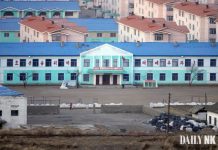On January 30 North Korea conducted its first test of the Hwasong-12 ballistic missile since 2017, which marked its seventh missile launch of 2022 and potentially represented an important landmark in the country’s testing regime. The Hwasong-12 was one of three major ballistic missile classes that began testing in 2017, alongside the intercontinental range Hwasong-14 and Hwasong-15 which had estimated ranges of 10,000km and 13,000km, and has an intermediate range estimated at 4,500km. Unlike its longer range counterparts designed primarily to be able to deliver nuclear warheads to the United States mainland, the Hwasong-12’s primary role is to target American military facilities on Guam – namely Andersen Air Force Base and Guam Naval Base which are central to the U.S. Military’s ability to project power in the Western Pacific. Secondary roles include holding other key hubs of the U.S. Military’s regional supply lines such as the growing facilities on Tinian Island and Wake Island under threat, both of which are within the missile’s range. These facilities are thought to have received investment for significant expansion largely due to the growing threat posed to Guam, not only from the Korean People’s Army (KPA) but also from neighbouring China which deploys the more sophisticated Dongfeng 26 missile with a similar role and range to the Hwasong-12. The U.S. military’s diversification away from reliance on Guam has also included possible moves to base long range bombers in Australia where they will be considerably safer from ballistic missile strikes.
A resumption of testing of the Hwasong-12 could indicate a new phase in North Korea’s missile program. Testing reached several landmarks in 2017, the last time the country was launching missiles with comparable intensity to January 2022, including the demonstration of the ability to strike cities across the entire United States mainland with nuclear warheads which American intelligence later confirmed had been demonstrated. The first test launch of the Hwasong-15 ICBM in November 2017 was followed by a pause that lasted throughout 2018 as Pyongyang pursued detente with the Donald Trump administration, culminating in summit meetings in June 2018 and February 2019 the latter which ended in a breakdown. Although the KPA resumed ballistic missile testing from May 2019, these were notably relegated to short ranged tactical designs intended primarily for use on military targets on the Korean Peninsula itself. The most notable was the solid fueled KN-23, which along with later enlarged derivatives effectively revolutionised the country’s theatre strike capabilities and moved them past Cold War era designs. The KPA has since early 2019 tested a range of ballistic and cruise missiles, which escalated in 2021 to include the longer ranged Hwasong-8 that was first launched in September and integrated a hypersonic glide vehicle. None of these, however, matched the range the Hwasong-12 demonstrated on January 30, with the new test potentially marking the beginning of more launches aimed at developing an ability to strike American territories further afield.

It has been widely speculated that North Korea could eventually follow the Hwasong-12 test with a test of an ICBM, possibly a second Hwasong-15 test or a first test of the new Hwasong-17 that was unveiled in October 2020. Considering the state of relations with the United States, however, it appears more likely that the KPA would avoid escalating to such a level immediately and could first focus on developing ‘Guam Killer’ missiles with similar ranges to the Hwasong-12. These could include the Pukkuksong-4 and Pukkuksong-5 solid fuelled submarine launched ballistic missiles first seen in October 2020 and January 2021 that are expected to significantly improve the strike capabilities of the country’s navy. While likely struggling to strike the U.S. mainland, ballistic missile submarines would comfortably be able to threaten U.S. bases on Guam, Tianjin and Wake Island. Alongside these programs, developing its hypersonic glide vehicle technologies further could be a major step for the KPA towards strengthening its intermediate range arsenal. This would also be a major source of prestige as the country could become only the second in the world after China to field tactical missiles with glide vehicles. With no defence system expected to be able to neutralise such vehicles in the foreseeable future these technologies could be a force multiplier which, if refined for tactical roles in East Asia, would provide a stepping stone for later use on the country’s intercontinental range arsenal much as Russia has done with its Avangard glide vehicle. Thus demonstrating a viable hypersonic glide vehicle armed missile capable of threatening Guam, possibly as a further development of the Hwasong-8, could potentially be an important goal for the KPA.
The nature of the Hwasong-12 as a very long ranged asset makes its resumed testing a potential landmark that could herald many more intermediate or longer ranged launches in future. Beyond the technical benefits of improving the KPA arsenal, such testing could also increase pressure on Washington to negotiate a deal with greater urgency and thus avoid an escalation that would add to its already very long list of imminent foreign policy concerns. While the future of North Korea’s missile tests remains highly uncertain it will likely be closely tied to the kinds of concessions the United States will be willing to offer in exchange for their suspension and other restrictions on the country’s arsenal, with the Biden administration having called for direct talks hours after the Hwasong-12 test. With Pyongyang having indicated repeatedly that it is eager to see economic sanctions resolutions that were primarily pushed through by the United States at the United Nations Security Council in 2016 and 2017 lifted, long range missile testing as in previous years provides a means of applying pressure to accelerate the process.




















